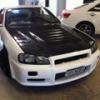Climate Control -off- Button Broken
Announcements
-
Similar Content
-
Latest Posts
-
Forgot to update. I ended up removing it and found out that it's dead. The car seems to run better than it did, although I haven't driven it hard yet. Literally just a flow restriction.
-
^ This is all good advice. I can imagine that there's some passive components in the HVAC controller that run that PWM output that could die, or suffer bad solder joints. It can be worth opening it up, taking a schmooze around looking for swollen electro caps, evidence of liquid escape anywhere, tracks that have been hot, lifted, cracked, etc. A DMM might not be suitable for seeing if the PWM output is pulsing. Might be too fast and too low voltage for a DMM to keep up. An analogue voltmeter might give a better hope. I use a handheld oscilloscope (<$100 from Aliexpress if you want something cheap). A DMM might see the voltage across the motor flicker. Otherwise, as above. If you can successfully see PWM action, then the control side should be good. If you can't see it with what you have, you might need to step up the instrumentation used, as above. Beyond that, and dbm7's advice on testing the motor directly, you're down to looking for broken wires, corroded connector pins, etc.
-
So Thanks for the comments etc. To follow up on this, we went down the path of fitting a divider down the middle of the external pipe that was added to the exhaust manifold and the divider went from very close to the external wastegate all the way up to the "V" part where the pipes from each side of the manifold joined. After this modification it was finally in a position to do the dyno-tune with some degree of success. Top end power was down about 10kw (250rwkw down to 240rwkw) I believe from previous but it seems to be more responsive lower down and at least it is now driveable and fun and back on the road to be enjoyed. Apparently the timing couldn't be run the same as it was running into knock and boost was down about 1psi. For all we know this could have been from the fuel being a bit older, or perhaps some slight complication from the new head gasket as we didn't have compression figures from before that mod to compare. I'm no mechanic and this is second hand info but I just wanted to follow-up to those that commented or read the original post with interest. After so many months of stuffing around this is a big win. The interesting part was most of the info around this was gained from information around Barra motors and not GTR as the manifold setup on the Barra with single turbo was more similar. Thanks for those that helped with info. Regards Rob
-
G'day ... first up, I very much doubt that's a resistor network (as used also for this job), but the part# looks right. The description of 'power module assembly' looks to be nissanese for 'PWM driven, ground switched, DC motor speed controller'.... the circuit in the schematic kinda infers that's the case... ...with the transistor symbol appearing in the unit described here as 'Fan Control Amp(lifier)'....being driven by pin20 on the HVAC unit, and a feedback signal on pin19 from the motor negative terminal for some reason (might be motor fault detection, maybe they detect commutator switching to determine motor revs as well, I dunno)... but if they are counting commutator spikes, a bad segment (or really worn brushes) will throw a spanner in the works... The motor itself will as said be brushed DC with segmented commutator, rated at 12VDC nominally ~ now-a-days I just unplug them, determine the positive wire, and hook them up to a variable power supply and find out how much current they draw, if they work etc etc ...you can also check for bad segments...ie; set the power supply up to feed 1volt @ 2amp max, then watch the wattage count as you slowly rotate the fan blower motor through a complete revolution ; any bad/dead segments will be clearly evident...some folks would just say determine the positive wire, and feed it battery voltage, and if fan spin, you've got a win...<grin>... well, at least that infers it should do something when plugged back in, and the HVAC unit commands it to run... and if it doesn't, you suspect the module, but you should check the PWM signal on pin20 is actually present, and if it is, blame the module ...
-






Recommended Posts
Create an account or sign in to comment
You need to be a member in order to leave a comment
Create an account
Sign up for a new account in our community. It's easy!
Register a new accountSign in
Already have an account? Sign in here.
Sign In Now